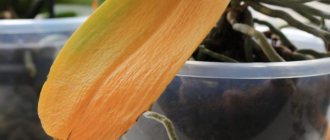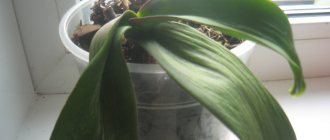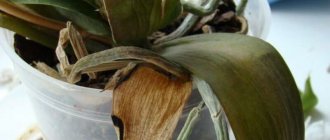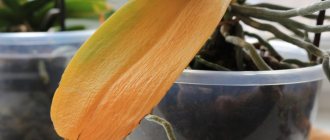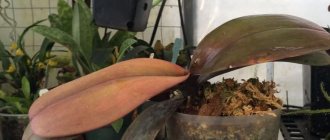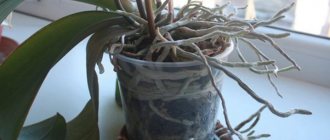Orchid is one of the most beautiful plants suitable for growing at home. As a rule, long stems with graceful flowers attract all attention. However, the leaf blades can be the first to signal that the orchid is sick or is not being cared for properly. Sometimes novice gardeners get carried away with flowering and notice too late that the plant needs help. Therefore, questions arise about if all the leaves of an orchid have fallen off, what to do in such a situation.
Natural process
The orchid as a tropical flower (genus Phalaenopsis) has many varieties and each differs not only in appearance or color of buds, but also in its life cycle. The latter, with an eye to climatic conditions, involves shedding leaves.
That is, if the greenery of your orchid suddenly begins to fall off, then it is possible that the primary source of the problem is its life cycle . Some species shed their leaves within a year after purchase, while others lose their leaves after 3-5 years.
All your efforts in terms of increasing/decreasing temperature, frequency of watering and applying fertilizers will not give any significant results. You just need to accept it and wait for the flower to form new leaves. If the gardener closely monitors the orchid, then he also tracks the age of the foliage.
Important! Before purchasing a plant, be sure to check with the seller for the exact name of the species and how often it sheds greens.
If an orchid begins to shed its leaves at the moment of rapid growth, then this is abnormal. During this period, greenery is necessary for the flower for complete photosynthesis, oxygen saturation and evaporation of excess moisture. So here we have an exacerbation of one or even several of the problems described below.
general information
In their tropical homeland, these flowers live on other plants. For example, on trees, without parasitizing them. The conditions in which they live are very different from those organized for them at home.
Watering the house should be sufficient, but not excessive. About once every 7 days is the norm for orchids. If you water more often, rotting and slow death of various parts of the flower may begin. If you water the orchid too rarely, then drying out will begin, which will also negatively affect the health of the plant.
In the hot season, and with “artificial” heating, you need to check the degree of drying of the soil. If its surface is barely damp, it means it can be watered. It is also a convenient solution to purchase a container with transparent walls, as this makes it possible to visually control the humidity of the substrate. That is, if condensation has collected on the walls of the pot, then it is too early to water.
In summer, the procedure is often carried out by immersing the pot in a container of water. This can be done several times a month. On other days, the flower is sprayed.
The temperature should not exceed +28 °C during the day and not lower than +18 °C at night. It is important to ensure that there are no critical differences of about 15 degrees Celsius, because in this case serious damage to the condition of the flower will be caused.
As for lighting, it is advisable to place the flower pot in partial shade or create diffused light for it.
Fertilizing is best done during the plant's dormant period, as well as during the plant's active growing season. Nitrogen-phosphorus-potassium fertilizers are considered an excellent solution. Macro and micro elements and mineral salts are often used in combination with them. You should be careful with minerals and strictly follow the dosage.
Important! Good orchid care requires proper organization and care.
Watering
Under no circumstances should you oversaturate the soil with moisture: the roots will begin to rot and the leaves will fall off. But the lack of fluid also has an extremely negative effect on the condition of the root and aerial parts. If a flower experiences a moisture deficiency, then soon all the leaves of the orchid will fall off . The greenery will try with all its might to retain water, and evaporation will stop working altogether.
You need to water your orchid regularly and without fanaticism, and not just when you remember that you have it. Here it would also be useful to clarify the subspecies: both moisture-loving types of orchids and “drier” types are found on sale.
Important! Make sure that the soil is slightly moist at a depth of 2-3 cm and do not allow the soil to dry out, compact or fall off.
It is best to water an ordinary orchid with boiled water at room temperature. This will slow down the development of functional chlorosis. Cold liquid can cause the roots to freeze, and all the leaves of the orchid will fall off again. If the plant is moisture-loving, then you can periodically give it a warm shower using a spray bottle. To prevent moisture from stagnating in the pot, be sure to provide drainage holes.
If you flooded the flower and brought it to rotting roots, then the soil must be replaced. The orchid is carefully removed from the pot and completely cleared of soil. Using garden tools, it is necessary to remove not only rotted roots, but also those areas on which a slimy coating has appeared.
Ideally, the cuts should be rubbed with activated carbon, then the plant should be placed in new soil and left alone for several days. After rehabilitation, the first watering is carried out no earlier than 4-5 days later.
Preventative care at home
- If it overflows, check the pot. Watering should be as close as possible to natural conditions: moistening, drainage. The soil must dry out completely. Drying is ensured by good air circulation. The soil should be undamaged and light.
- If the roots are damaged, the orchid must be removed from the pot and the black and dried areas removed with a sharp knife. Sprinkle the cuttings with charcoal, then plant the plant in a moist substrate.
- If it overheats, you need to create shade and avoid watering and spraying. Allow the plant to cool for 2-4 hours, then water as usual. Water balance is restored within 4 days.
5/5 — (1 vote)
Lighting
Another reason for the falling of flower leaves is lack of lighting. The orchid is extremely demanding of diffused sunlight. In the summer months there are no problems with this due to longer days, while in winter the plant suffers from a lack of light.
During this period, the flower needs an additional source of photosynthesis. It is best to organize artificial additional lighting with special LED lamps. The latter work in the yellow or white color range. Red, blue or green shades are not allowed here.
Separately, it is worth mentioning direct sunlight. They can also cause leaf drop. In its usual habitat, which is the tropics or subtropics, the orchid receives diffused light. Direct sunlight can cause severe burns. The leaves turn yellow, after which they simply die.
Important! If you take the plant out onto the loggia in the summer, be sure to cover it with gauze or a mosquito net. This way you will protect the orchid leaves from burns.
So the quality of light must be kept under control. Scattered rays can be organized using blinds or tulle curtains.
Basic rules for caring for orchids
An orchid will preserve its health and decorative properties for a long time if you create conditions in your home that are close to natural, natural for its growing environment.
Did you know? The Orchid family originated on Earth about 145 million years ago.
The plant needs to ensure compliance with the following requirements:
- Lighting . Moderately bright, diffused (one option is a light-diffusing curtain), without direct sunlight.
- Daylight hours are 13–15 hours.
- Temperature . Daytime temperature range is +18...+27°C, nighttime - +13...+24°C. When flowering stops, you will need to reduce the daytime temperature to +12°C, and the night temperature to +10°C. This will cause the flower a little stress, and it will begin to bud. Then you should gradually return to normal temperature conditions.
- Air humidity . Optimal - 60–70%.
- Location - east or west windows.
- Watering . Once a week, less often in winter. Watering is carried out by two methods - either by immersing the container with the plant in water or by the shower method. Water for irrigation should be at room temperature, soft, or boiled water may be used.
- Soil . The best option is a prepared substrate from store-bought soil for orchids and small amounts of expanded clay (or polystyrene foam), sphagnum moss, oak or pine bark, seed husks, charcoal and perlite added to it. The additives will loosen the soil and improve the flow of air to the root system of the flower.
- Feeding . This is done during active growth and flowering of the orchid twice a month. It is recommended to use ready-made store-bought fertilizers.
Fertilizers
Incorrectly selected fertilizers can cause problems with leaves. The answer to the problematic question lies at the purchase stage. Sellers, for the sake of rapid growth, as well as acceleration of sales, oversaturate the soil with nutrients and strong stimulants.
The plant quickly grows tall and acquires extensive foliage. But this approach also has a downside. After some time, the flower begins to wither from excess feeding, because it has exhausted all its resources for the formation of the above-ground part. And as a result, even seemingly healthy green leaves begin to fall off.
To normalize the condition of the orchid, it is necessary to place it as close as possible to the light source and completely abandon artificial fertilizers. After about a couple of weeks, you can begin to fertilize the soil with liquid fertilizers rich in nitrogen elements.
Important! Never oversaturate the soil with nitrogen fertilizers. This will delay the onset of flowering and make it more difficult to transport water and nutrients to the root.
The mirror problem is the lack of fertilizers . If the leaves of a flower begin to turn yellow and fall off, this indicates a potassium deficiency. In this case, mineral fertilizing cannot be excluded, but on the contrary, provide the orchid with fertilizers rich in iron and potassium. It would also be a good idea to completely renew the soil.
Orchid root is especially sensitive to elements such as nitrogen, potassium and phosphorus. If you dose them incorrectly, leaf fall will become a natural phenomenon. The root will receive a chemical burn and will no longer normally absorb nutrients from the soil. As soon as a couple of green leaves have fallen, you need to reconsider the scheme for applying mineral fertilizers.
Why does an orchid drop all its leaves?
Improper care always provokes premature shedding of leaves and buds. The flower slowly withers and dies. The reasons may be the following:
- lack of lighting;
- choosing the wrong place in the room;
- incorrect choice of substrate;
- violations of humidity and watering;
- temperature changes;
- pest infestation.
If measures are not taken in time to eliminate unfavorable factors, the plant may die.
Change of place
A change of location is a stressful factor, as a result of which the flower can shed its leaves. When moving it to a new place, you need to leave it alone for a couple of days. Avoid watering and fertilizing. If after a while the plant does not wither, the leaves remain turgor, watering can be continued as usual. If the orchid begins to wither, the place was chosen poorly.
Transferring a plant from a store to an apartment at sub-zero temperatures can trigger the shedding of not only leaves, but also buds. When purchasing in winter:
- the flower must be well wrapped to prevent hypothermia;
- monitor the root system: after watering it is especially sensitive to cold air;
- after a change of location, the plant requires a period of adaptation and good care conditions.
Important! There is a classic sign of health: new growth should be no smaller in size than the previous one, and larger in young plants. If these conditions are not met, it means that the care process is disrupted and the orchid is on the way to death.
Temperature violation
The temperature of the apartment is well suited for growing flowers. They do not have a pronounced rest period. In order for the plant to feel good, it is necessary to observe the temperature regime:
- in winter, comfortable temperature is +20…+25 °C;
- in summer the air temperature should vary between +25…+28 °C;
- For abundant flowering, a slight difference in day and night temperatures of 5–7 °C is needed.
If the ambient temperature is above +30 °C, the upper parts of the flower heat up. The roots cool down, stop consuming the required amount of water, and the leaves do not receive nutrients. As a result, dullness, yellowing, and fading are observed. Everything happens quickly, within a few hours.
It is important to ensure that there is no prolonged drop in temperature, which can be fatal. When exposed to prolonged low temperatures, the roots stop absorbing moisture, the leaves lose turgor and fall off.
Peculiarity! Beginning gardeners may confuse hypothermia with a lack of moisture and increase watering, which will aggravate the situation and lead to rotting of the roots.
Wrong location
In an apartment, choosing the wrong place can cost an orchid its leaves. She does not like drafts, which contribute to hypothermia, especially in winter and after watering. When ventilating the apartment, it is necessary to remove flowers from drafts.
The same applies to direct sunlight. They can cause burns and damage the plant. The location should be:
- light and warm;
- without drafts and direct sunlight;
- there must be access to fresh air.
The ideal location would be windows in the northern and eastern directions. If the flower pot is on the windowsill in winter, it is better to place it on a hill and make sure that the leaves do not lean against the cold window.
Unsuitable soil
The orchid has very delicate, fragile roots. The substrate must be light, hygroscopic, well breathable, and not deteriorate. The mixture may contain:
- pieces of tree bark;
- moss;
- expanded clay;
- charcoal.
The plant will feel great in clean tree bark. The substrate must be checked regularly and damaged and destroyed elements removed.
Attention! Orchids are epiphytic plants that cannot be planted in dense soil. Roots need fresh air.
If the plant begins to shed its leaves, it is worth checking the substrate for integrity and possible rotting. In this case, it is better to replace the soil with fresh one. Moisten the soil before planting.
May fall off due to pests
Insect pests suck the juice from their soft tissues and carry various diseases of bacterial or fungal origin. If the upper parts begin to fall or wilt, the plant should be checked for the presence of parasites.
Most often, orchids are damaged by:
- thrips;
- false scale and scale insects;
- aphid;
- spider mite;
- whitefly;
- fungus gnat;
- mealybugs and rootbugs.
Pests can be found both on the upper parts and in the substrate. If they are found, do not panic: any gardening store offers a range of preparations. Insects are destroyed by chemical treatment.
After disinfection, the number of pests decreases, but the likelihood of their reappearance is quite high. This is due to the fact that insects have a larval stage in which the pest can tolerate several chemical treatments absolutely painlessly. Therefore, for each species, repeated treatment with a drug is carried out at different intervals, which destroys the larva when it becomes mobile and begins to feed on its own.
Due to watering errors
Before watering, you need to determine whether the orchid needs moisture or has enough moisture. In order for the roots to actively absorb moisture and deliver it to the leaves, optimal light and thermal conditions are necessary. If there is not enough light, the roots freeze in growth or “pupate.” If the roots are bright green and thick, this indicates their active growth phase. The orchid can be watered abundantly: the roots will deliver moisture to the leaves.
Mistakes when watering an orchid:
- Watering from a watering can. It must be remembered that the roots are not in the ground, but in the substrate. When watering with a watering can, the water quickly pours out of the pot, the substrate and roots do not have time to soak. As a result, dehydration begins, leaves fall and death.
- Abundant watering in hot weather. Temperatures above +35 °C are a stress factor for an orchid. It freezes, the mouths on the leaves close, through which the moisture evaporates. Excessive watering can only do harm.
- Water should not get into the axils of the leaves.
- Spraying should be avoided. Water on leaves and flowers can cause the flowers to become stained and faded.
- Watering with hard cold tap water. A coating of salts will form on the walls and roots, which will lead to plant disease.
Interesting! A bright green dot at the edge of the root means that the light is weak and not enough. In this state, the roots stop absorbing moisture, and watering must be reduced.
The optimal irrigation option is the immersion method. The flower pot is placed in a container of water for half an hour. At this time, the orchid will be saturated with water in the amount it needs.
Lack of fertilizers
The orchid needs regular feeding. It grows in a substrate poor in nutrients, so feeding is vital for it. But biological features limit the use of universal fertilizers for flowering plants.
For the growth and beauty of an orchid you need:
- Nitrogen. With a lack of nitrogen, the leaves are small, limp, light green in color or with yellow marble spots, and growth is slowed down.
- Phosphorus. Deficiency of the element manifests itself in redness of the leaves, weakened turgor, and lack of flowering.
- Potassium. One of the most important elements for an orchid. With a lack of potassium, the lower leaves fall off and there is no growth or flowering.
- Calcium. With a deficiency of the substance, plant tissues are weakened and growth is slowed down.
Nutrients will be better absorbed if you feed them by immersing them in the solution for 10 minutes or spraying them on the root system.
Low air humidity
Orchids are tropical plants and need fresh, moist air. Signs of insufficient humidity with regular feeding are as follows:
- the tips of the leaves turn yellow;
- leaf turgor is weakened;
- leaves and unopened buds fall;
- the plant withers.
The following methods can be used to increase air humidity:
- place a steam generator or humidifier nearby;
- place the plant near an aquarium or decorative fountain;
- place a flower in a florarium;
- place the pot in a tray with wet filler (expanded clay, moss, pebbles).
Important! When organizing a florarium or greenhouse, it is worth remembering air circulation. Air freshness is one of the main factors in plant health.
May be thrown off due to incorrect transplantation
The most suitable time for transplantation is spring. At this time of year, the plant enters the vegetative stage. The main reasons for replanting a plant include:
- Poor condition of the soil (if the soil has decomposed, it remains wet for a long time after watering, and rot appears in the pot).
- The root system is affected (the roots are dried out, black, with spots).
- The leaves began to turn yellow and fall off (not to be confused with the natural change of leaves).
The plant must be carefully removed from the pot. Rinse the root system under running water. You cannot tear off parts of the substrate with your hands, as this can damage the root system. After this, dry and plant in a new substrate. A healthy flower will grow immediately after transplantation.
Priming
If an orchid drops its leaves, then one of the reasons may be improperly selected soil. Caked or overly compacted soil can cause roots to rot or dry out. If you get a flower with improperly formed soil, the plant needs to be replanted.
For novice gardeners, there is a huge selection of soil in specialized stores specifically for orchids. Experts prefer to prepare the soil for their flowers themselves.
Approximate composition of a good substrate:
- expanded clay;
- pine bark;
- White sand;
- sphagnum moss;
- perlite;
- fern;
- pumice.
Important! To organize a drainage layer (3-5 cm), only expanded clay and pumice are used.
You can change the percentage of ingredients depending on the subspecies of the flower.
Features of orchid growth and development
An orchid is a tropical flower that has a dormant period during which it stops its vegetative growth. Because the plant cannot constantly be in the growth stage and grow foliage or bloom constantly.
An orchid loses its leaves during natural aging.
If the plant stopped growing its green mass, and the grower did not change his care for it at that time, it means that the plant decided to take a break and went into retirement. Because part of the year the orchid grows its leaves or buds, and part of the year it rests. This is what is called the rest period.
Rest period
Orchid plants with a clearly defined dormant period are available for sale. They need to arrange rest periods when the substrate where the flower is planted is completely dried.
At this time, all or several leaves fall off, and their growth begins again in the spring. This can happen with:
- Tunias;
- Calantheas;
- Some species of Dendrobium (Nobile).
These species can rest from a month to two. But when the noses of the leaves begin to appear, watering begins and fertilizers intended for orchids are applied.
Temperature
All types of orchids can be divided into three temperature groups - warm, moderate and cold. A good half of the subspecies belong to the last two. An indicator of an incorrectly chosen temperature regime is precisely the falling leaves of an orchid.
“Warm” species prefer temperatures around +15-18⁰С. In this case, daily fluctuations should not exceed 5⁰C. For example, if at night the temperature drops to +18⁰С, and during the day rises to +25⁰С, then the flower may get sick.
Important! Check with the seller which temperature group the flower belongs to. It is better to avoid purchasing “warm” subspecies that are picky about the quality of the microclimate. It is very difficult to create ideal conditions for them.
Orchids of the moderate group feel great at +12-22 degrees and no longer react so critically to daily fluctuations. “Cold” species can easily withstand minimum temperatures up to +7⁰С and maximum temperatures up to +22. Daily fluctuations are also treated stoically.
What is leaf fall?
The process can be natural in the natural environment, when the plant sheds old leaves to grow new ones and rejuvenate itself. But it can also happen for reasons of leaving.
What factors precede this phenomenon?
You can determine the imminent fall of leaves for one reason: where the leaf is attached to the base, it begins to turn yellow and darken. Or it withers and turns yellow completely.
Natural and unnatural process
This reason can relate to both natural leaf drop and serious diseases, which can cause the plant to die. It is recommended to periodically inspect the leaves and feel them. A signal for unnatural falling will be the roughness of the surface, which usually has a smooth texture (why do plant leaves crack?).
Natural shedding of foliage occurs after a year of flower life, and new and healthy leaves appear in place.
The plant may be in hibernation, moments when an unfavorable period occurs in the natural conditions of the flower. You can find the necessary information on the Internet using the specified type.
Dry air
In order to maintain optimal temperature conditions, many place orchids near heating devices and central heating radiators. This is a mistake, because as a result of such proximity the air dries out, leaving the orchid without leaves.
The fact is that water evaporates not only from the soil, but also from the greenery itself. The plant loses moisture and the leaves begin to gradually die. The answer to this problem is to periodically spray the orchid with water at room temperature from a spray bottle.
Moist moss placed near the flowerpot also helps. It is able to concentrate moisture in itself and share it with other plants. The main thing here is not to overdo it, otherwise fungus may appear.
Pests and diseases
Violation of maintenance rules can lead to orchid disease. In order to identify the problem in time and begin treatment at an early stage, you should periodically inspect and feel the plant. It is still possible to cure a flower from a fungal or microbial infection, but help with an infectious lesion will be almost ineffective.
Experiencing temperature changes, abundant watering and lack of water, the plant becomes vulnerable to various types of rot.
- Root rot occurs from high humidity. The roots and soil are treated with a 2% solution of Fundazol.
- Gray rot covers aerial roots, leaves and flowers with a gray fluffy coating. Damaged parts of the plant are cut off, the cut area is sprinkled with activated carbon, and treated several times with a fungicide.
- Black rot is characterized by the appearance of weeping dark spots in the middle of the leaves. Diseased leaves are removed or disinfected and treated with Topsin.
- Fusarium - distinguished by a pink powdery coating. The leaves are treated with the antifungal agent Fundazol.
Leaf spotting appears from sunburn; wet spots quickly spread and lead to the death of leaves. They must be removed and the sections sprinkled with colloidal sulfur fungicide.
Dampness and poor air circulation, stagnation of moisture in the leaf sinuses lead to the appearance of black spots with a fluffy pink or yellow coating - these are characteristic signs of anthracnose and powdery mildew. They are combated by removing the affected leaves, followed by treating the cuts with Topsin.
In addition to diseases, pests may appear on the plant, not only on weakened, but also on apparently healthy flowers. Most often, orchids suffer from sucking parasites such as aphids, scale insects, scale insects, and small whitefly butterflies. Symptoms of their appearance are small dots on leaves and shoots. These are puncture marks through which insects feed on plant sap. Pests are removed using a soap shower, followed by treatment with Fitoverm, Chlorophos, Actellik.
Slugs and woodlice love dampness, but do not tolerate water. To drive them to the surface, the orchid is watered abundantly.
The worst pests are all types of mites. They can only be viewed through a magnifying glass. When affected, the leaves begin to dry out, becoming covered with a white coating in the form of a cobweb. Apply soap wiping and spraying with acaricidal preparations at intervals of 10 days. When midges and bugs appear, Aktara is a good means of control.
Changes in the color, structure and density of leaves noticed in time will help save the plant.
Compatible with other colors
The death of leaves on an orchid can be caused by neighboring plants. The flower is not particularly picky about its fellows, but still cannot tolerate some representatives of the flora in principle. Therefore, it is better to keep her as far away from them as possible.
Plants incompatible with orchids:
- Yucca.
- Araucaria.
- Cactus.
- Peperomia.
- Cordilina.
Here it is important not just to move or rearrange the orchid a little further from the above plants, but to separate them radically - by rooms or completely abandon one of the flowers.
Wrong neighborhood
To eliminate all the negative factors that can depress the plant, you should pay attention to its maintenance in everyday life, as well as what flowers live nearby. The orchid is capricious and demanding, loves light and space. If its neighbors are plants with heavy energy, then, experiencing stress, the entire leaf of the flower may fall off. Representatives of the agave family (yucca, cordyline) and succulents growing nearby need to be moved to another room.
What you should pay attention to
If the leaves begin to wither and fall off closer to the base of the peduncle, then this may be normal. Here we have the normal aging process. There is nothing you can do about this and there is no need to worry about it: the issue will resolve itself.
Examine the leaflet carefully. If the base that was attached to the stem is rotten, then it is necessary to check the roots, and at the same time the soil moisture. This condition of the leaves indicates waterlogging of the soil.
Lumps or plaque on the greens indicate a fungal infection. It appears either from the same excess moisture or from neighboring plants. To minimize the consequences, it is necessary to reduce soil moisture levels and use fungicides.
When the leaves become covered with multi-colored spots and then begin to fall off, this indicates that the flower has been infected by a virus. Treatment must be carried out immediately, otherwise the orchid will die in the shortest possible time. Fortunately, there are plenty of effective and inexpensive preparations specifically for orchids in flower shops.
If the rhizome and stem have received serious damage from the virus, then there is no point in saving such a flower. You will only waste your money on medications. It is much more practical to reproduce the old one or even buy a new one. Let us consider separately the root system of the orchid with an eye to our problem.
Rescue methods: step-by-step instructions
To help the orchid recover, you should follow some steps:
- Understand and figure out what is happening to the flower and why the leaves fall;
- Consider a new regime of watering, lighting or complete care;
- It is imperative to clean the roots from damaged areas, treat the cut areas with a special disinfectant powder, dry the flower itself well and treat it with a fungicide;
- We plant the treated and dried orchid in a new pot and secure it in it;
- To begin with, you can plant the plant in sphagnum moss - it will regulate the amount of water received;
- For the period when the leaves are just growing, it is better to place the orchid in a warm, well-lit place;
- We do not water for ten days, after which it is necessary to use a very light and gentle watering regime;
- if the leaves have fallen without rotting, then a special greenhouse can be used to restore the flower and grow leaves.
Green root
If the orchid has completely lost its foliage, but the root has not withered and remains green, then there is still a chance to revive the flower. In this case, photosynthesis and moisture saturation stop, but the plant still lives. By promptly identifying the cause, successful rehabilitation can be achieved.
A healthy rhizome indicates that the flower can still feed itself through the soil. Nitrogen supplements and fertilizing help here. It is undesirable to use strong growth stimulants. An adult plant survives any diseases noticeably better. Nutrients have already accumulated in its stems and roots, while in young orchids with a weak root system and a modest above-ground part, the problems are much more acute.
Overmoistening of the substrate as a reason
With constant flooding, the leaves of the plant become soft and begin to change their color to a yellow-brown tint. This comes from the fact that:
- Wet bark prevents oxygen from reaching the root mass;
- And the process of photosynthesis does not occur.
Overwatering can cause orchid leaves to turn yellow.
They begin to water the flower only when the bark has dried out by 2/3 of the pot and the condensation on the inner wall of the pot has disappeared. By this time, the roots become gray, which is also a signal to water. Sometimes all the leaves of a plant can fall off.
IMPORTANT! Overwatering is also destructive, as are long dry periods for the plant. Therefore, it is necessary to develop a cyclic watering schedule so that there are no problems with the leaves and root mass.
Signs
Main signs of waterlogging:
- The leaves change their color to yellow. Not only the lower ones, but along the entire trunk;
- Leaf blades lose turgor and sag;
- Black spots begin to appear on the vegetative mass;
- The buds dry out and fall off;
- The roots rot and the bush easily falls out of the substrate.
Measures to save the plant
When overwatering an orchid, you need to do the following:
- Remove the flower from the bark and inspect the root system;
- Remove all parts of the roots and trunk that are black;
- Remove roots where there is no velamen;
- Treat the flower with a fungicide against bacteria that carry rot;
- Dry the sections and treat with an antiseptic;
- If there are a lot of roots left, then the flower is planted again in the bark, but at the same time in a new one, and the old one is not thrown away;
- If there are no roots, they begin to resuscitate the flower and increase its root mass.
Withered root
If the flower has lost all its greenery, and the root has withered, then you need to seriously think about replacing it: resuscitation will be very problematic, and the chances of success are minimal. The fact is that a dried out root system indicates the impossibility of self-feeding. The plant simply will not be able to grow foliage and stems, no matter how you fertilize it.
It is also not possible to propagate a dying flower. You can try to inspect the root collar. If you see small green buds on it, then the chances of resuscitation increase slightly. Otherwise, trying to restore the flower is meaningless.
To restore an orchid, you need a special fertilizer with a high nitrogen content, which must be combined with strong growth stimulants. The latter significantly speed up the resuscitation process and within a day the result will be visible. But again, the chances that an orchid will recover with a dried root system are extremely small.
What to do if all the greenery has fallen off?
There are several ways to resuscitate an orchid. Let's consider one of them.
- The stem that remains without leaves must be transplanted into moss.
- Proper watering is organized: every day - 1 tablespoon of water, which must settle.
- It is necessary to wait until the stem gets stronger and the root system begins to grow.
It is important to remember: an orchid planted in moss should not be located in drafts or in places where it can overheat.
Read more about whether it is possible to save an orchid without roots or without leaves and how to do this in a separate article.
Why does an orchid need it?
Thanks to it, during the active growing season, leaves, aerial roots and peduncles appear - all these parts communicate with each other and form a single system. That is, growth points develop the plant and create the prerequisites for the full functioning of the orchid:
- nutrition - with the help of leaves and aerial shoots.
- reproduction - with the help of children developing from buds on flowering shoots.
Therefore, for monopodial plants (for example, for the Phalaenopsis orchid), the absence of a rosette tip threatens death. The growth of the flower stops, it becomes unable to obtain nutrients.
For a sympodial orchid, its absence is not so dangerous. One shoot stops growing, but the rest continue to develop. This should not be ignored. If the area where new shoots ripen is affected by rot, the disease can spread to healthy tissue of the flower and to other plants. This is also evidence of inappropriate living conditions or illiterate care.





